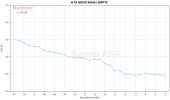This is a set of measurements of the Minidsp Flex HTx. It was sent to me by a friend. I have no affiliation to Minidsp. This set of measurements should not be directly compared to Amirm's test as I'm using Comos ADCiso here, but it should provide an general idea of performance of this gear.
I'm rather an amateur hobbyist so nothing is guaranteed here. Let me know if you think anything is wrong and I will look into it.
My measurements draw very little causal relation to how good this gear sound but rather how well this is engineered.
DA Performance:
The following measurements are measured from HTx's USB input.
4V SINAD:
Here is the 1kHz FFT at 0dBFS. This is measured with Cosmos APU(Analog Notch filter at 6dB), Scalar, and ADCiso.

Fair enough.
After FW1.1.17 Update, I got this:

Notice the huge drop in H2/H3!!!!
SINAD vs Generated Level:
This is measured with Cosmos APU(Analog Notch filter at 6dB), Scalar(autoranger), and ADCiso.

As expected.
Dynamics Range:
This is measured with Cosmos APU(60dB Preamp), A LPF, Scalar(autoranger), and ADCiso. It has to be measured with an LPF because Cosmos APU's preamp is extremely sensitive to HF noises so they have to be filtered out. A -60dB 1kHz sine wave was measured.

Someone might want to comment the little spikes around 5k. I have no idea what that is. My suspect is that it probabaly has something to do with APU's preamp.
Other than that, 64+60=124dB Dynamic Range. Pretty Good!
SMPTE vs Generated Level:
This is measured with Cosmos Scalar(autoranger mode), and ADCiso.
Our old friend ESS Hump here. An ESS engineer told me 9017s EVB does not have this hump. Should we blame ESS for not teaching all his customers how to get rid of this problem or should we blame Minidsp?

The Hump issue is also fixed in FW1.1.17:

Jitter Test:
This is measured with Cosmos Scalar(0dB as Impedance Bridge), and ADCiso. A 0dBFS 12kHz sine wave was measured.

Ugly, but I guess who cares?
Linearity:
This is measured with Cosmos Scalar(0dB as Impedance Bridge), and ADCiso. A set of 1kHz sine waves were measured.

SINAD vs Frequency:
This is measured with Cosmos Scalar(autoranger), and ADCiso. Without APU notch filter, it is expected that SINAD measured at 1kHz is slightly lower than the aforementioned 1kHz SINAD test.

[Revision Log]:
02/27/2024 First version
02/27/2024 Revision 1: Correct SMPTE Test
03/08/2024 Revision 2: Add SINAD vs Frequency Test. Some speculation on Multitone issue (See post #2).
03/19/2024 Revision 3: Updated measurements of FW 1.1.17. Sadly, the Multitone issue still persist.
I'm rather an amateur hobbyist so nothing is guaranteed here. Let me know if you think anything is wrong and I will look into it.
My measurements draw very little causal relation to how good this gear sound but rather how well this is engineered.
DA Performance:
The following measurements are measured from HTx's USB input.
4V SINAD:
Here is the 1kHz FFT at 0dBFS. This is measured with Cosmos APU(Analog Notch filter at 6dB), Scalar, and ADCiso.
After FW1.1.17 Update, I got this:
Notice the huge drop in H2/H3!!!!
SINAD vs Generated Level:
This is measured with Cosmos APU(Analog Notch filter at 6dB), Scalar(autoranger), and ADCiso.
As expected.
Dynamics Range:
This is measured with Cosmos APU(60dB Preamp), A LPF, Scalar(autoranger), and ADCiso. It has to be measured with an LPF because Cosmos APU's preamp is extremely sensitive to HF noises so they have to be filtered out. A -60dB 1kHz sine wave was measured.
Someone might want to comment the little spikes around 5k. I have no idea what that is. My suspect is that it probabaly has something to do with APU's preamp.
Other than that, 64+60=124dB Dynamic Range. Pretty Good!
SMPTE vs Generated Level:
This is measured with Cosmos Scalar(autoranger mode), and ADCiso.
The Hump issue is also fixed in FW1.1.17:
Jitter Test:
This is measured with Cosmos Scalar(0dB as Impedance Bridge), and ADCiso. A 0dBFS 12kHz sine wave was measured.
Ugly, but I guess who cares?
Linearity:
This is measured with Cosmos Scalar(0dB as Impedance Bridge), and ADCiso. A set of 1kHz sine waves were measured.
SINAD vs Frequency:
This is measured with Cosmos Scalar(autoranger), and ADCiso. Without APU notch filter, it is expected that SINAD measured at 1kHz is slightly lower than the aforementioned 1kHz SINAD test.
[Revision Log]:
02/27/2024 First version
02/27/2024 Revision 1: Correct SMPTE Test
03/08/2024 Revision 2: Add SINAD vs Frequency Test. Some speculation on Multitone issue (See post #2).
03/19/2024 Revision 3: Updated measurements of FW 1.1.17. Sadly, the Multitone issue still persist.
Last edited:

